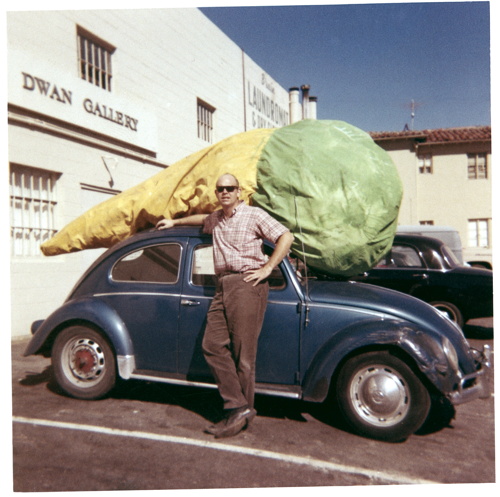
It’s not my strategy to leave pictures sitting on my desktop so long I forget where they come from, and then I don’t have to credit them or worry about posting them. If if were, I’d start a tumblr.
Given the amount of attention I’ve paid to various artists’ Volkswagens, I honestly thought I’d be writing something more extensive about Claes Oldenburg wheeling up to the Dwan Gallery with the giant Floor Cone Peggy sewed for him strapped on top of his car. But not yet.
And anyway, it’s been making the rounds, but I’m guessing it came from researching Sturtevant and Dwan Gallery a few months ago, and finding it on ArtObserved.
Tag: the vw years
The VW Years: Virginia Dwan Edition
Oh-ho, here is an awesome entry for The VW Years, greg.org’s ongoing mission to collect firsthand accounts of John Cage and Merce Cunningham’s VW Bus. The idea comes from the title of a chapter in dancer Carolyn Brown’s fascinating memoir, Chance and Circumstance: Twenty Years With Cage And Cunningham.
But this account’s from art dealer Virginia Dwan, in Artforum’s 500 Words, as told to Lauren O’Neill-Butler:
In New York, I became very interested in and involved with Minimalism and gave solo shows to Sol LeWitt and Carl Andre, and later Robert Smithson. When I moved the gallery to West Fifty-Seventh Street, I didn’t have enough space for them to do very large works, so I kept the gallery in Los Angeles with my assistant John Weber still working there, and I sent the artists out there to put up their shows. A favorite memory was when Merce Cunningham, John Cage, David Tudor, and Robert Rauschenberg drove from New York in a Volkswagen bus for one of Robert’s shows. They parked it in front of my house in Malibu and out of this bus came nine people. It was like a circus bus with endless people emerging. They had all driven from New York to Los Angeles and stopped along the way giving performances. I didn’t know how they all fit, yet there they all were in the bus.
The Robert she’s referring to has to be Rauschenberg, not Smithson. And it looks like Rauschenberg showed twice at Dwan’s Los Angeles gallery, in 1962, and 1965. The first show corresponds to what Brown called “the golden years” of touring, which ended in June 1964, when Rauschenberg won the Venice Bienale during the company’s tour of Japan, and it became a problem, and there was a messy split, so the idea of all these now-celebrities piling back into a VW bus and dance-busking their way to Bob’s show seems, at the very least, improbable.

So it was 1962, before Dwan’s New York gallery, and in her first LA space. Rauschenberg’s show ran March 4-31. The Dwan Archives at the Smithsonian give the title, “Drawings,” but there’s a little installation photo in Terry Schimmel’s Combines catalogue [above] that clearly shows Combines. From left: First Landing Jump (1961); Blue Eagle (1961); Black Market (1961); Navigator (1962); and Pantomime (1961). [Schimmel’s appendix note that Co-existence (1961), Rigger (1961) and Wooden Gallop (1962) were also in the show.]
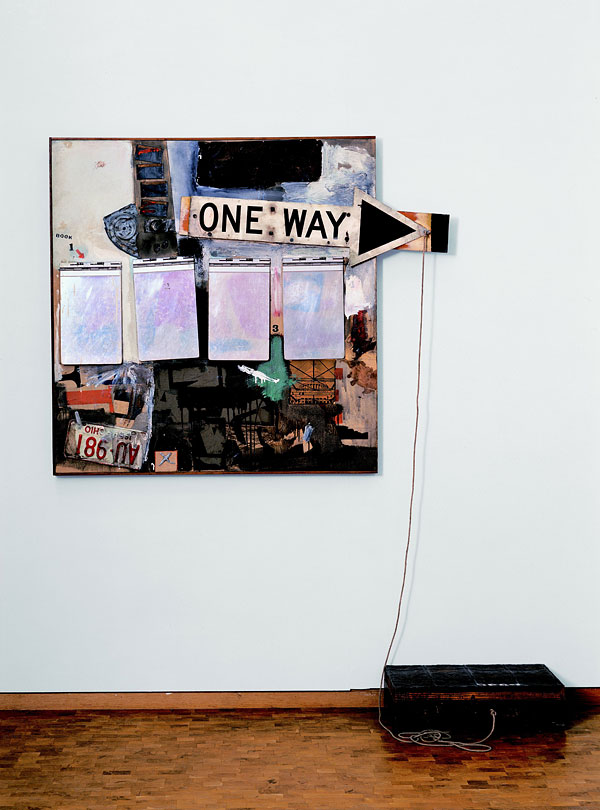
Robert Rauschenberg, Black Market, 1961, collection Ludwig Museum, Cologne
Black Market is an amazing and important work, and one that relates directly to another ongoing greg.org topic: Short Circuit and Jasper Johns’ Flag. Black Market contains a valise on the floor with various items and diagrams from Rauschenberg which viewers would exchange for a personally valuable item of their own. There’s a little Rauschenberg stamp pad, too, so everything you put in would be(come) a Rauschenberg. Think about that for a while.
It was first viewed in 1961 at the Stedelijk, and had its US debut at Dwan. There’s a lot more going on with this work, but it’s already too tangential for words right now. Suffice it to say, Jasper Johns was not on the bus.
Virginia Dwan | 500 Words, fortunately part 1 of 2 [artforum]
Previously:
The VW Years: Ch. 1 – 1957 – The Italian gameshow mushroom boondoggle
Ch. 2 1956-62 – Remy Charlip & Steve Paxton
Ch. 3 – John Cage
Carolyn Brown, Part I
Carolyn Brown, Part II, the real inspiration
The VW Appears: a snapshot from the John Cage Trust
The VW Years: Appendix: Living Theatre
The VW Years, Appendix: Living Theatre
Welcome to another episode of The VW Years, greg.org’s ongoing mission to seek out firsthand accounts of John Cage and Merce Cunningham’s VW Bus.
These are some mentions of John Cage in The Living Theatre: Art, Exile, and Outrage,, John Tytell’s 1995 history/biography of Living Theatre founders Judith Malina and Julian Beck, which were compiled by Josh Ronsen and posted to silence-digest, a Cage-related mailing list in 1998:
“At the end of September, they visited Cage and Cunningham who had expressed an interest in sharing a place that could be used for concerts and dance recitals. Gracious, unassuming, the two men lived in a large white room, bare except for matting, a marble slab on the floor for a table, and long strips of foam rubber on the walls for seating. The environment reflected their minimalist aesthetic. Cage proposed to stage a piece by Satie that consisted of 840 repetitions of a one-minute composition. He advised them not to rely on newspaper advertising, but to use instead men with placards on tall stilts and others with drums.” –pg 72
…
“the only person Judith admitted caring about was John Cage, “mad and unquenchable” with his “hearty, heartless grin.” With Julian, she visited Cage in Stoney Point in the Hudson Valley. … Julian thought Cage was the “chain breaker among the shackled who love the sound of their chains.” Cage collected wild mushrooms, which Julian interpreted as a tribute to his reliance on chance as much as to his exquisite taste. … [Paul] Williams wanted to help them find a new location that Cage and Cunningham could share with The Living Theatre.” -pg 121
“In the middle of 1957, they saw Cunningham dance at the Brooklyn Academy of Music to Cage’s music. At a party afterward, C&C laughed all night like “two mischievous kids who had succeeded in some tremendous boyish escapade.”” -pg 125
“[they] visited Cage in Stoney Point, where they made strawberry jam and gathered mint, wild watercress, and asparagus for dinner. Feeling a surge of confidence in his own writing, he [Julian] gave Cage a group of poems to set to music.” -pg 128
“With Judith, Julian, Cunningham, and Paul Williams, John Cage drove from “columned loft to aerie garage” in his Volkswagen bus, smiling despite the traffic and the fact that their search was now in its 4th month. Finally, they found an abandoned building, formally a department store on 14th st and 6th ave, which Williams declare would be suitable for sharing as a theatre and dance space.” – pg 129
“Early in December, with Cage’s assistance, [Cunningham] moved some of his backdrops into the space. Cage brought with him a variety of percussion instruments–he owned more than 300 at that time–which he donated to the theatre. Julian thought there was a distance about Cage that prevented intimacy and the fullest communication, but he felt Cage’s gift was a real sign of the artistic support that would be crucial to the success of The Living Theatre.” -pg 140
The VW Appears
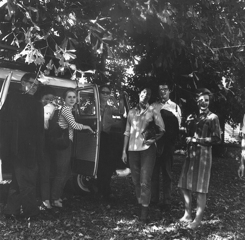
image: copyright the John Cage Trust, used with permission
So awesome. Last winter, I tried to dig up all the published firsthand accounts and references of The VW Years, Carolyn Brown’s term for the early days of the Merce Cunningham Dance Company, when the troupe would tour the country in John Cage & Merce’s white VW bus, which Cage had purchased using the winnings from a rigged Italian game show.
In addition, I’ve tried to figure out what happened to the bus itself. So far, no luck at all. But when she was helping with the transfer of the Cunningham Foundation archives to the NY Public Library, John Cage Trust director Laura Kuhn spotted this little image of the company hanging out next to the bus. And she very graciously sent it along. Many thanks.
The VW Years, Ch. 1
Ch. 2, Remy Charlip & Steve Paxton
Ch. 3, John Cage
The VW Years: Carolyn Brown, Part I, Part II
The VW Years: Carolyn Brown, Part II
After processing the odd hippie hipness of the idea of John Cage driving Merce Cunningham and his dance company around the country in a VW Microbus, it was really dancer Carolyn Brown’s excellent memoir that persuaded me to see the bus as central to this incredible, historic period. So I’m going to quote from an extended section of Chance and Circumstance: Twenty Years With Cage And Cunningham, and then expect everyone to go read it themselves. Because it’s an awesome tale of an exciting career. Brown really shows both self-reflection and an awareness of those around her. And those around her included some of the greatest artists of the last hundred years.
Anyway:
The VW Years: Carolyn Brown, Part I
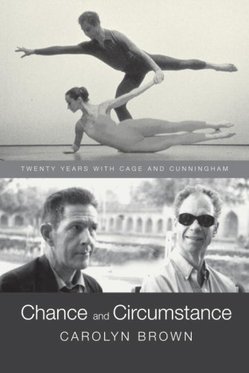 Well first off, apologies to Remy Charlip. I’d said he was “a bit off on dates” when he wrote about touring with Merce in a VW Microbus driven by John Cage from 1956-61. When we know [sic] that Cage only bought the bus in 1959, after winning a stack of dough on a rigged Italian game show.
Well first off, apologies to Remy Charlip. I’d said he was “a bit off on dates” when he wrote about touring with Merce in a VW Microbus driven by John Cage from 1956-61. When we know [sic] that Cage only bought the bus in 1959, after winning a stack of dough on a rigged Italian game show.
But now, who knows? Those dates match up perfectly with the memoir of Carolyn Brown, one of Merce’s first principal/partners, and, like Charlip, a member of the Company from the earliest Black Mountain College days.
In fact, the chapter of Chance and Circumstance which lent its title to this series of posts, “The VW Years,” begins in:
November 1956. John and Merce borrowed money to buy a Volkswagen Microbus, the vehicle that defined–willy-nilly–a classic era of the dance company’s history: the VW years. Our first VW-bus jaunt was crazily impractical, but according to a postcard sent to my parents, “a very happy trip.” To give two performances, we drove for two days and one-third of the way across the country and, although I don’t know how Merce was able to afford it, we stayed, for all the world like a professional dance company, in a big city hotel–the Roosevelt in downtown St. Louis. [p. 164]
What’s remarkable about these “VW Years” in the mid-50s was how little use the bus actually got. The centerpiece of the chapter is actually a groundbreaking Jan. 1957 performance at BAM that caused a downtown uproar–but which was followed by months-long stretches of absolutely nothing at all. The company performed so little in 1957 that Brown ended up joining the ballet corps at Radio City Music Hall, a grueling gig that left her exhausted and injured, but with money in the bank.
The detailed, finely, painfully felt atmosphere Brown conjures up is both eye-opening and engrossing; the rejection, ignoring crowds, poverty and hardship of this era of Merce & co’s career–indeed, of the whole downtown scene–seems hard to imagine from the comfortable, iconic present. And though I’m neither a big biography nor dance guy, I repeatedly found myself thrilled and literally laughing out loud at Brown’s stories.
The VW Years were also the Bob and Jap years, when Rauschenberg and Johns designed costumes and sets for the Company. In 1958, the two artists and Emile de Antonio produced a 20-year concert retrospective of John Cage’s work, followed in Feb. 1960 by a Manhattan performance for Merce’s company.
Merce worked out the program for what would turn out to be a “traumatic” New York performance on a tour through Illinois and Missouri:
After the eleven-day tour, six of them spent in the close quarters of our Volkswagen bus, everyone had or was getting a cold. In Viola [Farber]’s case the cold developed into bronchial pneumonia. By February 16 she was acutely ill. At the end of her umbrella solo in Antic Meet her legs were cramping so badly she barely made it into the wings. Merce, entering from the opposite side for his soft-shoe number, couldn’t help seeing her, on the floor in the wings, unable to walk, tears streaming down her face. Afterward he said that as he went through the motions of his solo his mind was racing: What happened? Will she be able to continue? What will we do if she can’t? At the intermission he picked her up in his arms and carried her upstairs to the women’s dressing room. The cramps finally subsided and she assured him she could continue. Cod knows how she got through Rune, but she did. [p. 260]
Brown is sympathetic but unflinching in her account of the difficulties of working with Cunningham, and of the toll the company’s lack of performances and new choreography took on Merce the dancer, who, in Brown’s telling, grew grim and depressed as he watched his peak physical years passing him by. By 1961, things were not quite so grim, with ten performances booked in nine states between February and April; which may make this the Golden VW Year:
I think Merce was even more relived than I to be touring with the full company, and his self-confidence seemed fully restored knowing that the company had been engaged on the basis of his reputation as dancer and choreographer rather than by avant-garde musical festivals based on John’s and David [Tudor]’s reputations. John and David were with us, of course, to play piano for Suite and Antic Meet. John, on leave from Wesleyan, also resumed his duties as chief chauffeur, cheerleader, guru, and gamesman. Once again, nine people tucked themselves into the Volkswagen Microbus, sometimes spending as many as eighteen out of twenty-four hours together. Singing, snoozing, reading, knitting, arguing, laughing, telling stories, playing games, munching, and sipping, we whiled away the hours and miles between New York City and De Kalb, Illinois, De Kalb and Lynchburg, Virginia…etc. We totaled six days and one full night on the road plus six hours in the air just to give four performances. Ridiculously long journeys. One performance we gave having had no sleep at all, dancing in Lynchburg, Virginia, on Tuesday night, then, after a party, driving all night to Richmond, Virginia, to catch a plane to Atlanta and another to Macon, where we performed Wednesday night after rehearsing in the afternoon. It was impractical. Exhausting. Wonderful. [pp. 313-4]
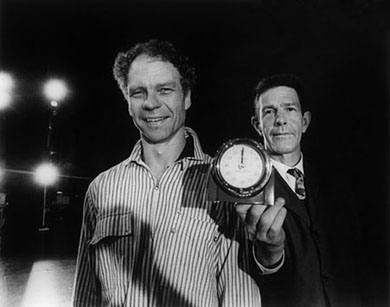
There’s one more excerpt which I’ll go ahead and quote from at length, where Brown really brings home the reason why I’ve become kind of fascinated with Cage’s VW bus in the first place. At 11PM, as the year ends, and Merce Cunningham Dance Company is performing for the last time at the Park Avenue Armory–and as I gave my tickets to these final Legacy Tour events to a good friend when I realized our travel schedule meant we couldn’t attend ourselves–and as Cage’s centennial year begins, I am looking forward to soaking in Brown’s insightful account of the scrappy, crazy, foundational era of the company and the artists in its orbit.

“The Final Bows: Merce Cunningham Dance Company, December 31, 2011” [@parkavearmory]
The VW Years, Ch. 3: John Cage
The VW bus makes many appearances in John Cage’s own writings, especially his tour diaries in Empty Words: Writings ’73-78:
After winning the mushroom quiz in Italy, I bought a Volkswagen microbus for the company. Joe’s was open but said it wasn’t. At Sofu Teshigahara’s house, room where we ate had two parts: one Japanese; the other Western. Also, two different dinners; we ate them both.
We descended like a plague of locusts on the Brownsville Eat-All-You-Want restaurant ($1.50). Just for dessert Steve Paxton had five pieces of pie. Merce asked the cashier: How do you manage to keep this place going? “Most people,” she replied rather sadly, “don’t eat as much as you people.” [p. 80]
…
Tarpaulin centered on the bus’s luggage rack, luggage fitted on it. Ends’n’sides were folded over; long ropes used to wrap the cargo up. [p. 82]
…
We were waiting to be ferried across the Mississippi. We had nothing to eat. We waited two hours. It was cold and muddy. When we decided to leave, Rick and Remy had to push the bus up the hill. Later we learned that the ferry service had been discontinued two years before. [p. 90]
…
Pontpoint: the company ate by candlelight. Everywhere we’ve gone, we’ve gone en masse. A borrowed private care took two, two such cars took six to eight, the Volkswagen bus took nine. Now airplanes and chartered buses take any number of us. Soon (gas rationing) we’ll travel like Thoreau by staying where we are, each in his own. [p. 95]
In Richard Kostelanetz’s John Cage: an anthology, the dance critic Stephen Smoliar recounted one story Cage told the audience at opening night of the company’s 1970 season at BAM:
The Cunningham Company used to make transcontinental tours in a Volkswagen Microbus. Once, when we drove up to a gas station in Ohio and the dancers, as usual, all piled out to go to the toilets and exercise around the pumps, the station attendant asked me whether we were a group of comedians. I said, “No. We’re from New York.”
This pushes back the end of The VW Years to the 60s at some point.
The VW Years: Ch. 2, Remy Charlip & Steve Paxton

[l to r] Viola Farber, Bruce King, Remy Charlip, Carolyn Brown & Merce Cunningham performing Nocturnes in 1956. photo CDF/Louis A. Stevenson, Jr. via the estate project
Remy Charlip was an early collaborator in Merce Cunningham’s orbit. Years before he began his second or third acclaimed career as a children’s book illustrator and author, Charlip danced with Cunningham and Martha Graham in New York and at Black Mountain College. He created the programs for the August 1952 Cage et al performance at BMC which is considered the first “Happening.” They were printed on cigarette paper, and were placed at the entrance next to a bowl of tobacco, with an ashtray on each seat.
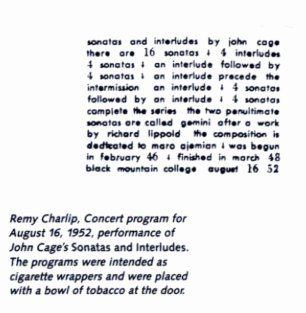
image of what has to be a Charlip program for a different Cage performance, via The Arts at Black Mountain College
Though he’s a bit off on the dates, what with Cage only buying the VW bus in 1959, John Held’s Charlip biography lays out the basic configuration of the bus:
As if BMC was not enough, Charlip received continuing post-graduate work from 1956-1961 in the back of a Volkswagen Microbus driven by John Cage, navigated by Merce Cunningham, enlivened by Robert Rauschenberg, with traveling companions Nicholas Cernovich and dancers Carolyn Brown, Viola Farber, Steve Paxton and others.
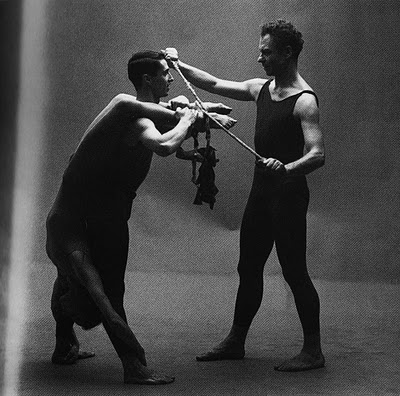
[l to r] Carolyn Brown, Steve Paxton & Merce Cunningham, 1961, image via cepress
A couple of weeks ago, Paxton talked to the Washington Post about the bus: Later that year [1960? ’61? -ed.] Remy resigned, and I was invited into the smaller company. This meant touring around the U.S. in a Volkswagen bus, which, I was informed, it was my duty to pack. And unpack. And distribute and later collect all the items packed. There were the spaces under the seats, a compartment in the back, and a roof rack to transport nine persons’ personal luggage, the equipment of John Cage and David Tudor for various musical adventures, and the sets and costumes for the tour. The bus was heavy laden, and it never let us down, including at least two tours the the West Coast.
John or Merce drove, and John liked to play Scrabble when off-duty. The rest of us conversed and Viola [Farber] knitted. It was rather like a family around the hearth. Long silence, naps, breaks to stretch and walk about, and usually some amazing treat produced by John, a huge salad perhaps, or once Rogue River pears at perfect ripeness with pear liquor to accompany. David was quiet, Marilyn Wood chatty, Carolyn [Brown] and Viola made comment, Merce sometimes spoke, John and Bob laughed a lot, and both were great story-tellers. I remember the actual driving fondly.
It may have been amidst family-like intimacy of the bus that Paxton and Rauschenberg started the relationship that ended the relationship between Rauschenberg and Johns in 1961-2.
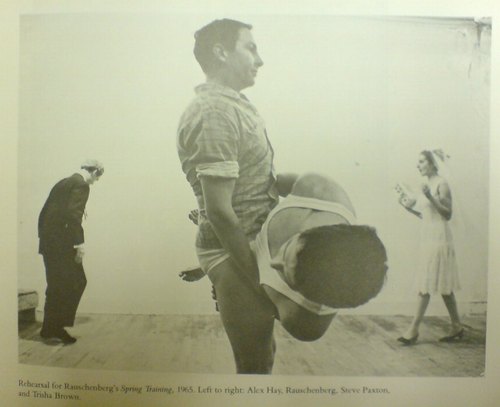
Robert Rauschenberg & Steve Paxton, with Alex Hay [l] and Trisha Brown [r] rehearsing Spring Training, 1965. image via SAAM Rauschenberg catalogue, 1976
The VW Years: Ch. 1
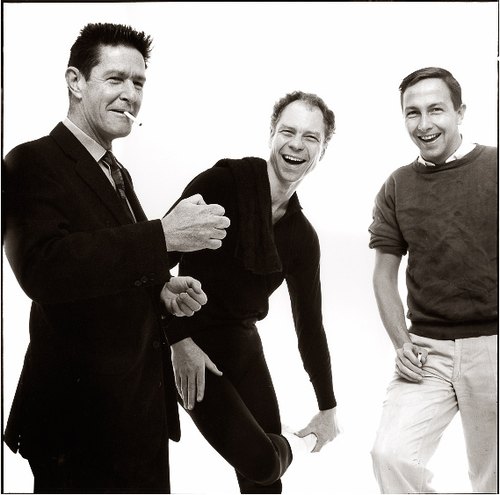
John Cage, Merce Cunningham, and Robert Rauschenberg photographed in 1960 by Richard Avedon
In a few days, the Merce Cunningham Dance Company will perform for the last time. I have not been a close follower of Cunningham’s work, except in the New Yorker way, how, for the two decades since I moved to the city, Merce and his company were an integral part of the cultural fabric. Merce? You’re soaking in it!
I was always more of a Cage fan. And so it’s been fascinating, and enlightening, and continually surprising over the last year or so, as I’ve been digging into the early days of Rauschenberg and Johns, trying to understand their formative work and context, to see how closely connected they were with Merce and John. How small the circle of artists was which generated so many incredible works and ideas. And yet how infrequently I consider their work in relation to each other, or consider the nature of their collaboration beyond the basic namecheck.
In a way, I guess Rauschenberg and Johns and their intense, but short-lived collaborative period serves as the antithesis of Cunningham and Cage’s lifelong partnership. But they all began so close, and so much together.
Anyway, as I’ve become more familiar and more admiring of Cunningham’s work and Cage’s work with him, I’ve begun trying to piece together the world they inhabited in the late 1950s and early 1960s, when they were just starting out. And one thing that comes up in every story about those days is the VW microbus Merce and his fledgling company would pile into to tour the country. Cunningham’s longtime principal dancer Carolyn Brown even titled the chapter in her 2007 memoir “The VW Years.”
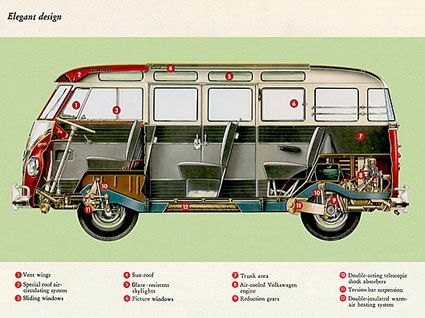
But I’ll get to that. First, the story of the VW bus itself, how John Cage bought it, and how it figured into various peoples’ accounts of those crazy, early days.
 In 1958, Cage had performed at a blowout retrospective concert organized by Johns, Rauschenberg, and hustler/activist/filmmaker Emile de Antonio; and he’d exhibited his scores at Stable Gallery. Then in the taught and performed in Europe, including at Expo ’58 in Brussels, and then settled into a several months’ residency in Milan at RAI, Italian state television. In February of 1959, after hanging out with Peggy Guggenheim at her Venetian palazzo, he appeared on Lascia o Raddoppia, the local equivalent of the $64,000 Question, where he performed new compositions, became famous by the end of the week–and ended up winning 5 million lira in a series of ridiculously rigged questions about mushrooms.
In 1958, Cage had performed at a blowout retrospective concert organized by Johns, Rauschenberg, and hustler/activist/filmmaker Emile de Antonio; and he’d exhibited his scores at Stable Gallery. Then in the taught and performed in Europe, including at Expo ’58 in Brussels, and then settled into a several months’ residency in Milan at RAI, Italian state television. In February of 1959, after hanging out with Peggy Guggenheim at her Venetian palazzo, he appeared on Lascia o Raddoppia, the local equivalent of the $64,000 Question, where he performed new compositions, became famous by the end of the week–and ended up winning 5 million lira in a series of ridiculously rigged questions about mushrooms.
And so he took his winnings and Italian fame back to the US, where he used part of the money to buy a piano for himself, and a white VW microbus for Merce and the company to tour in.
The most extensive accounts of the Italian game show boondoggle and the VW van purchase are from Begin Again, Kenneth Silverman’s Cage biography, and Stefano Pocci’s guest post on the John Cage Trust blog.
Lascia o Raddoppia, Milan, 1959 [johncagetrust]
